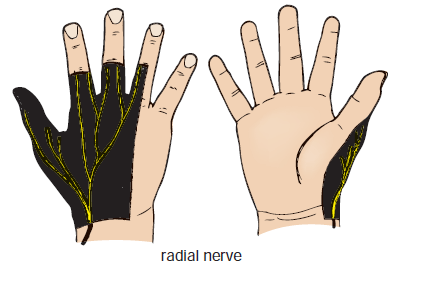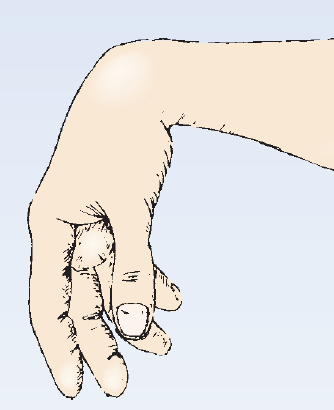Wrist Drop (Injury of Radial Nerve)
content of this page
1- Introduction
2- Anatomical Overview
3- Treatment
4- purposes
Introduction

Anatomical Overview
Damage to the radial nerve will result in paralysis of triceps, the anconeus, and the long extensors of the wrist. The patient is unable to extend the elbow joint, the wrist joint, and the fingers. Wrist drop, or flexion of the wrist, occurs as a result of the action of the unopposed flexor muscles of the wrist. Wrist drop is very disabling because one is unable to flex the fingers strongly for the purpose of firmly gripping
an object with the wrist fully flexed. (Try it on yourself.) If the wrist and proximal phalanges are passively extended by holding them in position with the opposite hand, the middle and distal phalanges of the fingers can be extended by the action of the lumbricals and interossei, which are inserted into the extensor expansions.

Treatment
Rest and Activity Modification: Avoid activities that put pressure on the radial nerve to prevent further damage.
Splinting: Wearing a splint or brace can help keep the wrist in a functional position and prevent further deformity.
Physical Therapy:
- Exercises: Strengthening and stretching exercises to improve muscle function and flexibility.
- Nerve Gliding Exercises: To help the nerve move more freely and reduce compression.
Medications:
- Pain Relief: Nonsteroidal anti-inflammatory drugs (NSAIDs) to reduce pain and inflammation.
- Corticosteroids: To reduce inflammation if there is significant swelling.
Occupational Therapy: Training in adaptive techniques and the use of assistive devices to help perform daily activities more easily.
Surgery:
- Nerve Decompression: If the nerve is compressed, surgery can relieve the pressure.
- Nerve Repair or Grafting: In cases of severe injury, surgical repair or grafting of the nerve may be necessary.
Addressing Underlying Conditions: Managing conditions such as diabetes or inflammatory disorders that may contribute to nerve damage.
Purposes
Restore Functionality: Improve the ability to move and use the wrist and fingers for everyday tasks.
Prevent Complications: Avoid further complications such as muscle atrophy (wasting) or joint stiffness.
Reduce Pain and Discomfort: Alleviate any pain or discomfort associated with the condition.
Improve Quality of Life: Enable the individual to perform daily activities independently and without significant limitations.
Prevent Long-Term Disability: Minimize the risk of permanent damage or disability by addressing the underlying cause and promoting nerve and muscle healing.